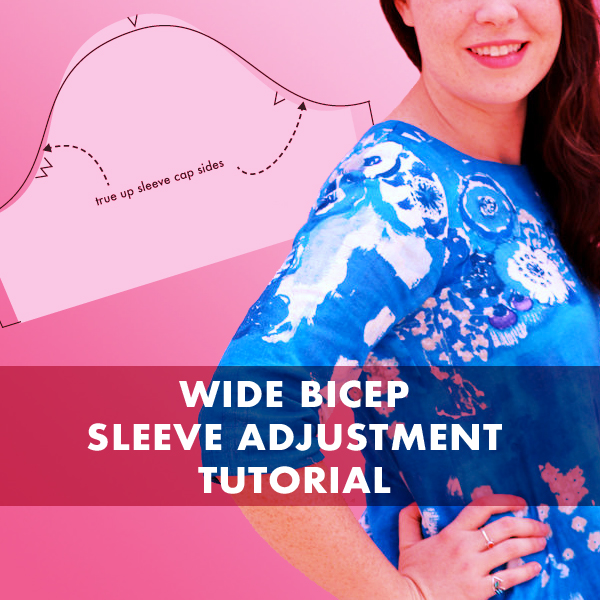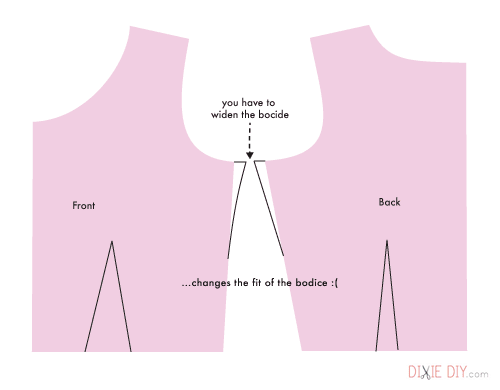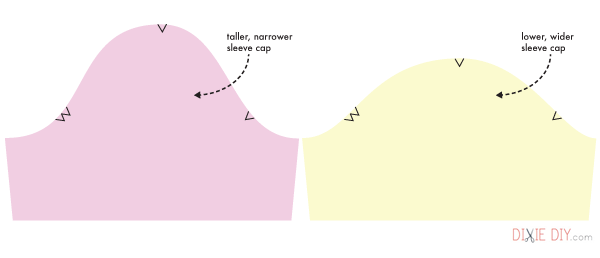Wide-Bicep Sleeve Adjustment Tutorial

In my Farrow Dress post I mentioned an adjustment I use to make a sleeve piece wider without altering the length of the sleeve cap seamline OR altering the bodice pieces.
The normal sleeve adjustment tutorials I’ve seen widen the bicep area but also lengthen the sleeve cap seamline which means you either have to ease in the extra length into the armhole (which can be difficult) or adjust the bodice pieces one of two ways:
By widening the bodice at the underarm point:

This can disrupt the fit of the bodice, however, not good.
Or, by lowering the armhole to add more overall length to match the sleeve seamline.

This can actually reduce your range of motion – also not good.
Instead, I use a different method that works on SOME pattern styles.
This method widens the bicep area, widens the upper arm area of the sleeve cap, and lowers the top of the sleeve cap.
Lowering a sleeve cap has the added benefit of giving your arm more range of motion BUT there’s a caveat – if you lower it too much you’ll start getting fabric bunching under your arms. You need to find a balance that works for you!
Because of this, this method works best on a sleeve piece that has a TALL sleeve cap because if your original sleeve cap is short to begin with, you may experience the “bunching” side effect.

(Tall sleeve cap vs short sleeve cap.)
Ikat Bag has an excellent blog post all about sleeves. Cannot recommend this post highly enough! Check out the “box” section for details on how different sleeve cap heights function in real life.
You will need:
- Your original sleeve piece
- Tracing paper and pencil
- Measuring tape and/or a flexible ruler like this one
Step 1: Trace
Trace your original sleeve piece. You may want to trace without seam allowances to make this easier. If you leave the SA on, be sure to include it in your measurement calculations!
Step 2: Measure
Measure the length of the sleeve cap itself. Make note of this number.
Measure your bicep and compare it to the width of the sleeve. You want 1-2″ inches of ease depending on the type of fabric.
For example, on my Farrow Dress, my bicep measurement was the exact same as the sleeve measurement. I knew that would be too tight so I decided to add 1.25″ in total width.
Whatever width you choose to add, divide that measurement in half. So if it’s 1″ – divide by half to equal 0.5″.
Step 3: Widen the sleeve
Widen both sides of the bicep area (right below the sleeve cap) by your half-measurement from Step 2. You can widen all the way to the hem or grade to the original hem.

Step 4: Lower the sleeve cap
Measure down from the shoulder point about a half inch (or more or less depending on the height of the sleeve cap, this is more of an art than an exact science) and re-draw the very top of the sleeve cap curve.

Step 4: Re-draw the cap curve
Here’s where the measuring tape/flexible ruler comes into play. You want to maintain the original length of the sleeve cap seamline. Widening the bicep made it longer but lowering the shoulder point made it shorter. This should even out the differences in length adjustments.
Use the tape/ruler to draw a new sleeve cap seamline by connecting the underarm points to the shoulder point. You’ll notice the sides of the cap itself will end up wider than on the original sleeve. This will also give you a little extra width in your upper arm area. Bonus points!

Step 5: Cut new sleeve piece
Transfer markings (and add back seam allowance if you removed it earlier) and cut out the new sleeve piece. Don’t forget to label your new piece with all your adjustments!

Let’s review the changes to the pattern:
If you measured correctly, your sleeve cap seamline length should be the same as the original but the shape will be different.
The sleeve cap is lower and wider than the original. The overall width of the sleeve is increased.
You now have more space for your arms as well as slightly increased range of motion.
All without any adjustments to the bodice!

This method may not be the best choice for all sleeve patterns but it’s one option you can use to get a better fit.